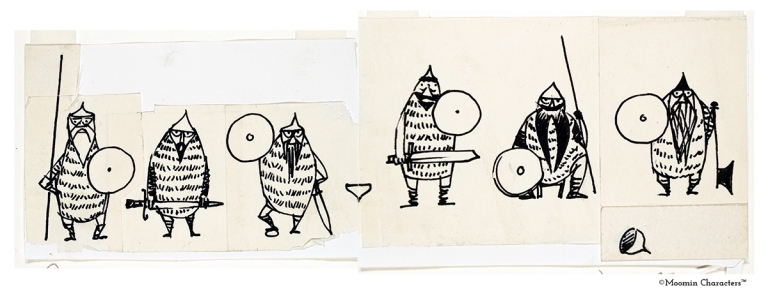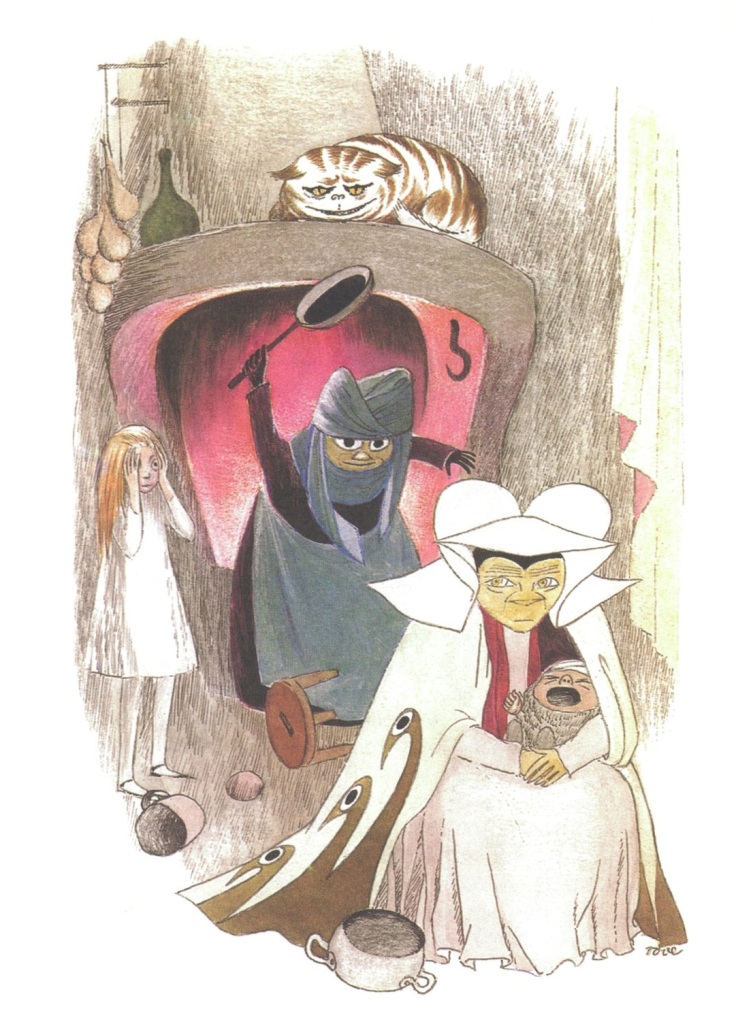The illustrations bear this out. Although there had always been a good deal of darkness on the fringes of sunny Moominvalley, The Hunting of the Snark is something of a progression. Tove sets her cast of familiar oddballs against a backdrop reminiscent of the dark imaginings of Edward Gorey. This was just the start of Tove’s journey into the dark heart of English children’s literature.
In November 1960 that other great of Nordic children’s literature Astrid Lindgren wrote to Tove imploring her to accept a commission to illustrate Tolkein’s Hobbit. The creator of Pippi Longstocking and Noisy Village, would act as publisher – and her hopes were sky high:
‘This will be the children’s book of the century and will live long after we are dead and buried.’
Tove was equally excited, but for different reasons. This was to be as different from the Moomins as possible. She told Astrid:
‘I have tried to free myself from my “Moomin style” with its careful line-drawing and painstakingly filled surfaces.’
To achieve this she was to use ‘poor quality paper (i.e. paper I did not respect) and to draw each figure freely again and again, 20, 40, 60 times… then I glued the result together.’

In Tove’s hands middle earth becomes more cinematic that any of Peter Jackson’s endless CGI fests. The landscapes are truly magical – just look at the bridge over Rivendell and its star strewn skies. Oh my, those skies.
She might have moved away from Moominvalley, but there are still unmistakable parallels here, particularly with her early books about impeding disaster like Comet in Moominland and the Great Flood. Once again the explicit aim was to capture a threatening landscape:
‘Forests of living horror, coal black rivers, moonlit moors with fiery wolves – a whole world of catastrophe.’
Not everyone was impressed though. To nail her point home about moving away from the character based illustration she was best known for, Tove took massive liberties with the much loved cast, either making them really tiny or, as in the case of Gollum, reinventing them all together. I suspect this is why we’ve never seen it in this country. What insult!
The Hobbit, despite its all-star line-up, flopped. But Tove’s next venture into the field of English sacred cows would exceed all expectations. Alice in Wonderland is her masterpiece, a work fit to sit alongside John Tenniel.
But, surprise, surprise, there were to be no fluffy white bunnies in this version, Tove again latched on to the latent horror.
‘The story is terrifying and can in no way be seen as an idyll, but it causes shivers of pleasure.’
Her original vision for the book was, according to her biographer Boel Westin, something akin to Hieronymus Bosch. Awesome as that would have been, it’s probably lucky that Tove’s publisher vetoed her plans. Though that’s not to say the book isn’t dark – it’s chock full of weirdness. Check out the full on body horror of one of Alice’s transformations.
Or the domestic violence in the Pig and Pepper illustration in which Alice’s eyes bulge in horror and even the Cheshire cat is shorn of his grin.
Unlike the Hobbit where Tove was perhaps trying a little too hard to present herself as an Artist, her Alice gets the balance just right. The darkness is counterbalanced by some of her best character sketches. The animals are particularly glorious.
She also appears to have got over her anti-Moomin hang ups, providing a Mad Hatter who could pass for a distant cousin of Snuffkin.
Ever wondered what a Studio Ghibli Alice might look like? Wonder no more. This wide view of the tea party could easily be concept art for a lost Miyazake.
Boel Westin writes that there was another ‘might have been’ that could have completed Tove Jansson’s trinity of horror writers. ‘Once when asked by a publisher to name a book or author she would like to illustrate, she answered unhesitatingly: Edgar Allen Poe.’ Just imagine her take on The Raven, or the Black Cat.
There’s a lot of horror in Tove’s work, Grokes, Hattifatteners and in the psychological short story A Tale of Horror (1962), monstrous Little My. ‘That girl… you’d never believe… I’m not going back there, not in a thousand years,” the Whomper continued savagely. “She tricked me! she told such stories! She makes people sick with her lies!’
Tove Jansson Life, Art, Words: The Authorised Biography by Boel Westin is published by Sort Of Books


















Oh, these are … unexpected. But delicious! In a weird way…
LikeLike